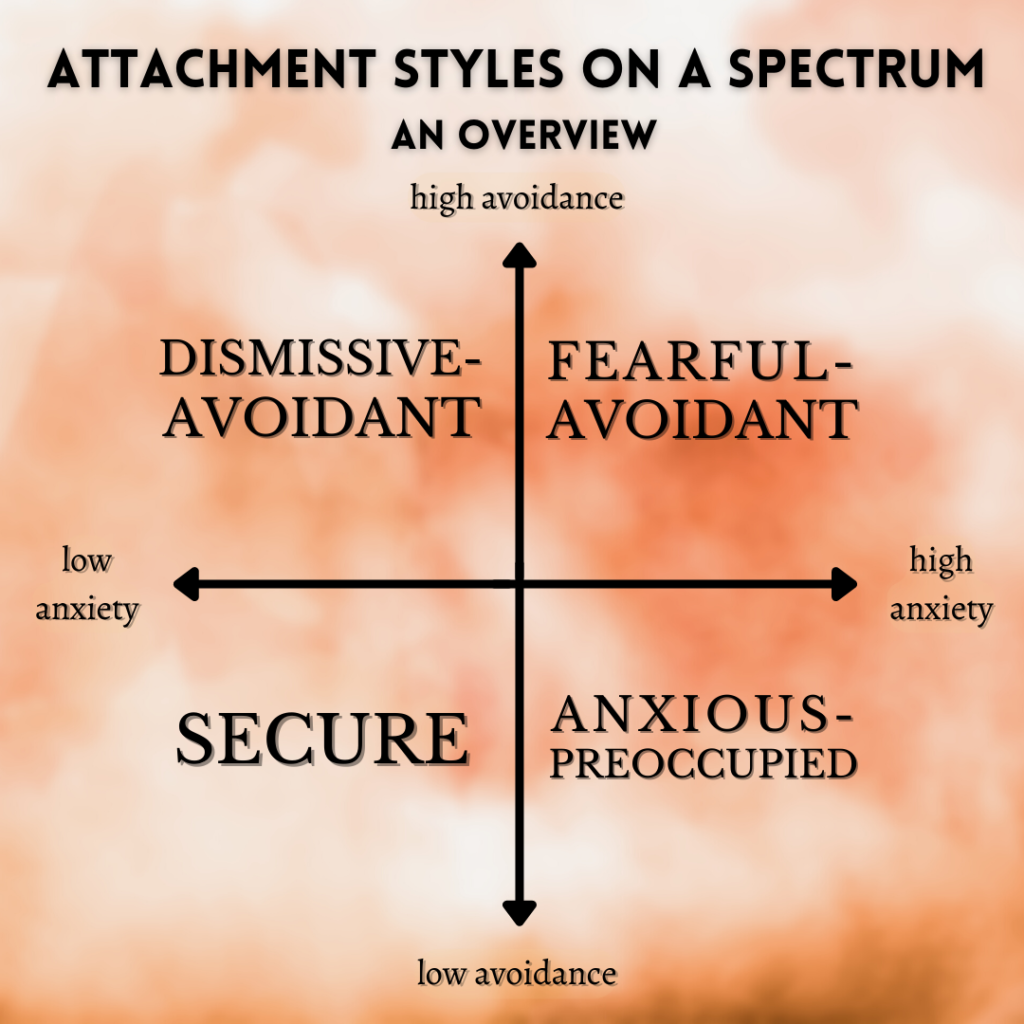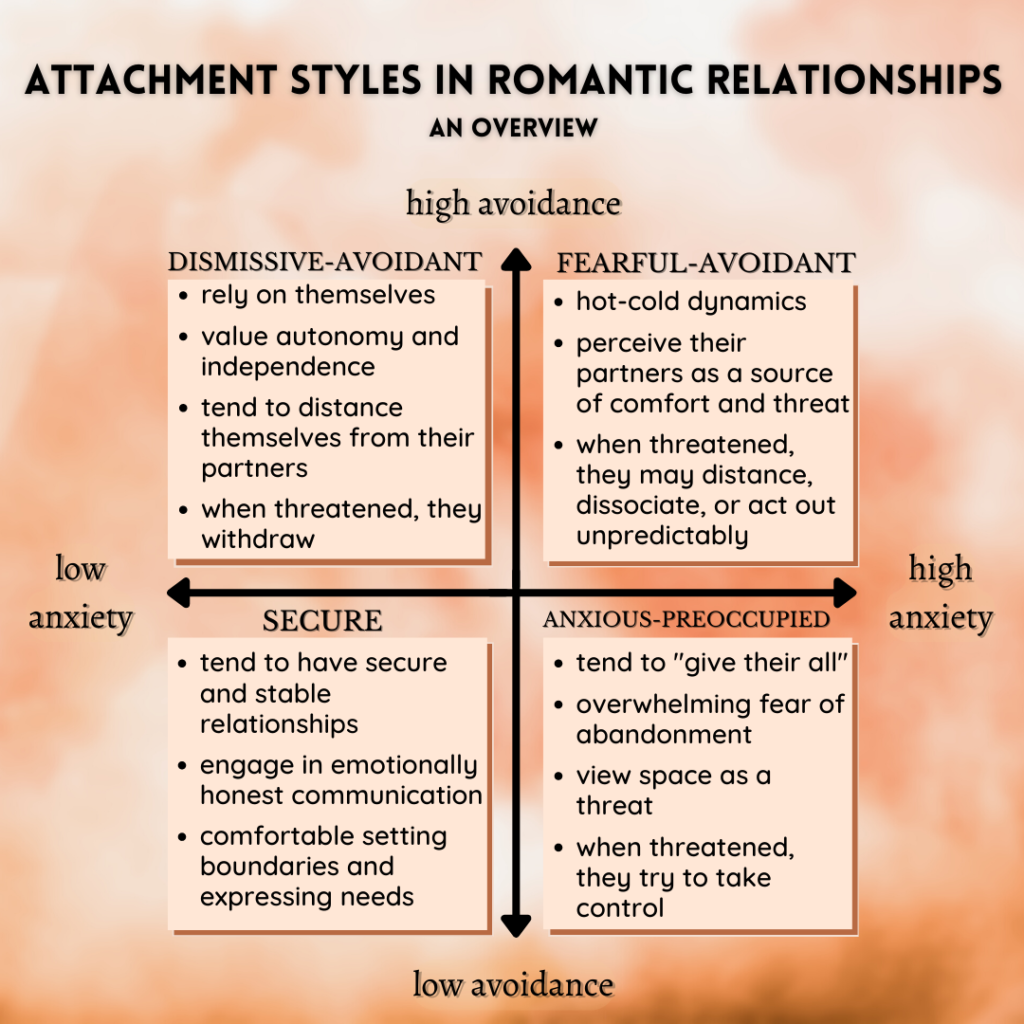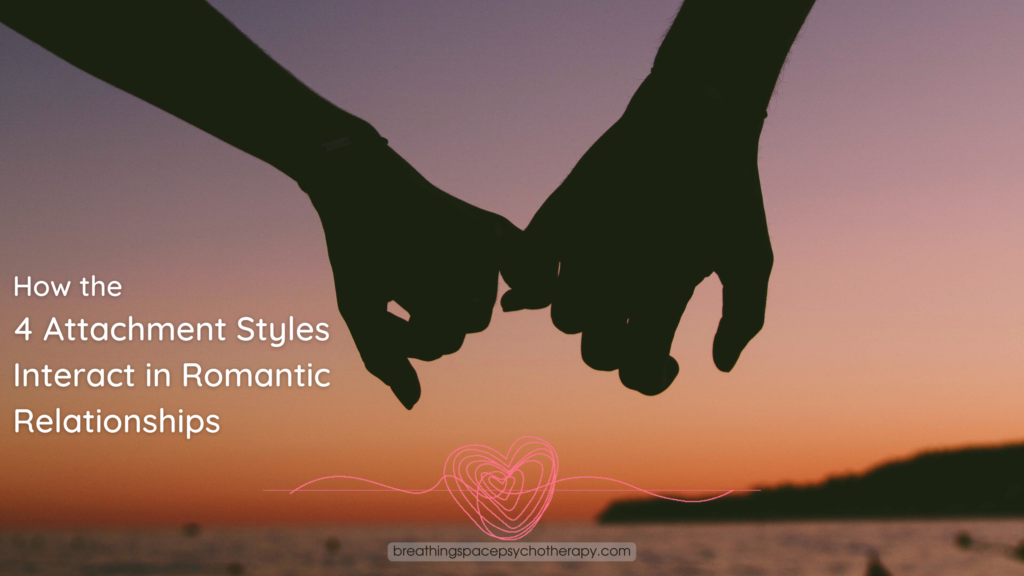What is attachment style?
Attachment style is the way you relate to others in close, intimate relationships.
Our attachment styles are first established when we are infants and are determined by the quality of our first bond with our caregiver.
If our caregiver makes us feel safe, understood, and accurately interprets and meets our needs, then we are more likely to develop a secure attachment.
On the other hand, if we experience confusing and inconsistent emotional communication and our caregiver does not accurately interpret or inconsistently meet our needs, then we are more likely to develop an insecure attachment.
Note: Insecure attachment styles are not mental disorders. Having an insecure attachment style is common; however, it can cause distress or harm relationships.
The first style is the only secure attachment and what we strive to achieve. The following 3 styles are insecure attachments
- Secure attachment (SA): These individuals are emotionally mature, resilient, and have a positive self-image.
- Anxious attachment (AA or AP): also referred to as anxious-preoccupied, ambivalent, or ambivalent-anxious attachment. These individuals struggle with low self-esteem and feelings of unworthiness.
- Fearful-avoidant attachment (FA): also referred to as disorganized, disoriented, or anxious-avoidant attachment. These individuals perceive their caregiver/partner as a source of comfort and fear.
- Dismissive-avoidant attachment (DA): These individuals avoid intimacy by withdrawing and distancing themselves.
Our attachment style established in childhood tends to be our attachment style in adulthood; however, intervening experiences between childhood and adulthood play a large part in shaping our attachment styles. Our attachment styles can shift and change based on healing, self-work, and traumas—both big “T” traumas and little “t” traumas.
Anxious and avoidant behaviors are a spectrum, which means you likely won’t perfectly fit your attachment styles profile. This means that an individual may have a secure attachment but leans avoidant, or two anxious attachments don’t experience anxiety to the same degree.

| What is your attachment style? Take one of these quizzes to find out! Both are free and only take five minutes to complete. Attachment Style Quiz (28 questions): This quiz requires an email to view your result and displays your percentage for each attachment style. Attachment Style Quiz: A 5-Minute Test To Find Out What Yours Is (31 questions): This quiz does not require an email and displays a single result and description of your attachment style. |
How do attachment styles interact in romantic relationships?
It’s important to note that your attachment style can change. It’s okay if you’re worried about your attachment style’s unhealthy behaviors and dynamics. The first step is to learn and recognize these patterns and tendencies, so then you may focus on healing and establishing effective and emotionally honest communication in your relationship.
As you’re reading, take note of any feelings, tendencies, and behaviors you notice in yourself and your relationships.
The 4 Attachment Styles in Romantic Relationships
Let’s look at how the 4 attachment styles approach and tend to behave in romantic relationships, and remember, you may not fit the profile 100%.

Secure Attachment (SA)
Secure individuals tend to have strong, secure, and stable relationships and also have more satisfying relationships. However, this does not mean every relationship is successful.
These individuals feel safe to be open and vulnerable, to express their feelings, and to share their fears, flaws, and weaknesses with their partners. They feel comfortable setting boundaries and expressing their needs.
An SA will assess their partners to see if their partners fit into their lifestyle, their dynamic, and can meet their needs. They will also assess if they can meet their partner’s needs and fit into their lifestyle, but they will not give up their sense of self or be a people-pleaser. The point of assessing is to find if all parties in the relationship are a good fit for each other.
When SAs are under stress, they may engage in anxious or avoidant behaviors. However, unlike insecure attachments, SAs are able to self-soothe and reach equilibrium quicker.
Anxious Attachment (AA or AP)
Anxious attachment is also referred to as ambivalent, anxious-preoccupied, or ambivalent-anxious attachment.
Individuals with an anxious attachment tend to romanticize love, and they will look for partners who will “fix” them. APs often feel like they need a romantic relationship and will “give their all” to make a relationship work to the point of self-sacrifice and personal abandonment.
APs may exhibit demanding, obsessive, possessive, needy, and clingy behaviors. They may be controlling and not want their partners to have friends or be close to their family or anyone else because they subconsciously feel that these people pose a threat to their connection with their partners.
Sometimes, APs misunderstand or don’t hear what the other person is communicating as a way to (subconsciously) avoid the pain of abandonment and rejection. They tend to overanalyze, personalize, and may misinterpret their partner’s actions as affirmations of their fears. APs will use activating strategies—such as justifications, explanations, and excuses—to get closer to someone and stay connected.
Fearful-Avoidant Attachment (FA)
Fearful-avoidant attachment is also referred to as anxious-avoidant, disorganized, or disoriented attachment.
Individuals with a fearful-avoidant attachment face a lot of inner conflicts: they want to be close but fear intimacy.
FAs exhibit both anxious and avoidant tendencies: they fight between wanting to stay and wanting to leave the relationship because they perceive their partners as a source of comfort and fear. When these individuals feel both anxious and avoidant impulses in the extreme, it results in deactivation and a dissociative shutdown.
FAs desire love but believe they are unloveable, fear intimacy, and distrust others. They may think, “Why would my partner want me? There must be something wrong with them.”
These individuals are often described as emotional storms, emotional roller-coasters, or hot-and-cold and display unpredictable behaviors that may be confusing to their partners.
In the beginning, they encourage closeness, and they feel a powerful connection with their partners, but later, almost overnight, they no longer feel interested in their partners. The “coldness” stems from feeling vulnerable, distrusting others, and thinking their partners will reject them, so they retreat or withdraw from their partners before their partners can reject them.
Dismissive-Avoidant Attachment (DA)
Individuals with dismissive-avoidant attachment tend to be emotionally distant and self-sufficient—often described as cold, aloof, and a loner.
DAs value independence and will distance themselves from their partners because they believe these behaviors preserve their autonomy and freedom. They feel that commitment or intimacy is uncomfortable and stifling and may downplay their partner’s emotional attachment to them.
Similar to FAs, DAs feel uncomfortable opening up and being vulnerable because they feel like the other person will have power over them.
When the relationship is under stress or in an emotional situation, DAs have the ability to shut their emotions down and pretend they don’t care. They tend to push other people away before others have a chance to reject them, and in general, keep everyone at arm’s length because they fear being criticized. They often judge themselves as shameful and defective, so they don’t want others to “figure them out.” These behaviors will often result in emotional dismissal, isolation, and deprivation.
The 10 dynamics of the 4 attachment styles
The associated colors are in accordance with mindbodygreen’s “red-light, green-light” system.*
- Green indicates that the two attachment styles are a good fit. This dynamic is more likely to create a stable ground for a loving and healthy long-term relationship.
- Yellow indicates that the relationship should be approached with caution. The relationship can become strong and secure if the person(s) with the insecure attachment style works on healing themselves.
- Orange indicates that the relationship should be approached with caution. Both attachment styles will need to engage in self-work and engage in effective communication.
- Red indicates that the dynamic will create significant challenges. This does not mean that the relationship will never work out. If the person(s) with an insecure attachment style works on healing themselves, then the relationship can become successful, loving, and secure.
*The “FA with FA” and the “FA with DA” dynamics are changed to red due to these dynamics’ tendency to polarize each other. Thus, this dynamic falls into the anxious-avoidant trap and the FA’s unpredictable and volatile nature.
Secure with Secure
Two SAs will create a safe space in their relationship where they can express their feelings and needs, be vulnerable, share their fears, and learn about their partners.
Both parties are open and receptive to love, validate each other’s feelings, and establish their boundaries. They feel secure and connected with their partners and independent yet loving. They offer support to each other and feel comfortable going to their partners when they are distressed or upset.
When a problem arises in the relationship, both secure individuals have the tools to navigate the challenge. Secure individuals may engage in anxious or avoidant behaviors when under stress. However, these individuals are not likely to become emotionally volatile and will reach equilibrium faster than other attachment styles.
These individuals are also willing to have tough conversations to assess what each individual wants in the relationship and their lives. That way, they can plan accordingly to move toward the lifestyles and relationships they want.
Secure with Anxious
In this relationship, the AP often feels safe, loved, and validated by the SA. The SA can assess and meet the AP’s needs.
The AP may be afraid of communicating exactly what they want, but the SA loves and encourages open communication. The SA feels comfortable setting their boundaries. However, this may make the AP feel threatened and that their secure partner is rejecting them.
The AP tends to believe that their romantic partner will “fix” them or that their partner is their “better half.” While the SA will create a stable and safe space for their AP partner, the SA knows they cannot “fix” their partner. The SA will offer support, validation, and encouragement for their AP partner. But, if the AP does not heal their attachment wounds, the SA may burn out and/or leave the relationship.
Secure with Fearful-Avoidant
The FA may feel grounded by the SA’s nonreactive, stable energy.
The SA may be drawn to the FA’s passion, and the FA may be drawn to the SA’s safety and stability.
The SA offers the love and affection their FA partner desires. However, this often triggers shame and guilt within the FA because they feel they are unworthy of their secure partner’s love and attention. The FA craves intimacy yet fears it, so if they feel the relationship is becoming too intimate, they may disengage.
The SA’s stability and open communication may encourage the FA to overshare. But, when FAs overshare, they tend to regret it afterward and quickly retreat into themselves. This can leave their SA partner feeling hurt or rattled when neither communicates their needs, fears, boundaries, nor triggers.
Secure with Dismissive-Avoidant
SAs do not pair well with DAs. The SA wants to connect, but the DA fears intimacy and is often too distant and detached.
The SA understands the DA’s need for space and independence. But the SA can still feel hurt, unloved, and upset by their partner’s avoidant behaviors. SAs love engaging in open and honest communication, so they may express their feelings to their DA partner and look for co-creative solutions. The DA can use this chance and space to address their attachment wounds. Or, the DA may end the relationship then and there. The DA may think they can’t give their secure partner what they need and that someone else can make the SA happier.
If the DA continuously disengages, the SA may first approach their partner and create the space for them to explain themselves. However, if the DA continues their avoidant behaviors and doesn’t communicate, the SA will likely leave to find someone who will meet their needs.
SAs can also become anxious in the relationship if their needs are not met by the DA, which can trigger a DA to pull away more.
Anxious with Anxious
If one AP is higher on the spectrum than the other anxious individual, then it may “turn off” the lower AP and make the latter dismissive.
When they don’t effectively communicate, then both APs’ fears and insecurities silently grow, which can be emotionally draining. However, two APs can create a deep bond because they are able to understand each other’s tendencies, needs, and fears. This requires that both APs are aware of their attachment wounds and effectively communicate within the relationship.
Anxious with Fearful-Avoidant
These two attachment styles may quickly and intensely connect with each other, which can later create challenges for their relationship.
In the beginning, the relationship starts passionately and appears stable and strong. The FA encourages connection and the AP latches onto the connection and the relationship.
Initially, the FA feels safe with their AP partner: when their anxious partner clings to them, the FA feels validated and needed. However, after a while, their anxious partner’s clinginess may trigger their avoidance wounds. This avoidant behavior may result in the FA pulling away, becoming volatile, or shutting down quickly.
When the FA pulls away, this triggers the AP’s attachment wounds of feeling like they’re not good enough and are unlovable.
Usually, an FA is less volatile with an AP than with a DA.
Anxious with Dismissive-Avoidant
APs and DAs do not pair well; however, they may attract each other and engage in a push-and-pull dynamic known as the anxious-avoidant trap.
The DA’s behaviors tend to make the AP feel unloved and unwanted. The AP is more likely to internalize and perceive their DA partner’s behaviors as their fault.
Meanwhile, the AP’s behaviors tend to make the dismissive individual feel crowded, suffocated, and controlled. The DA often feels frustrated because they don’t understand why they need to reassure and validate their anxious partner. They may also feel like their anxious partner expects too much of them because they can’t meet their partner’s needs.
Fearful-Avoidant with Fearful-Avoidant
One of two situations may occur when two FAs date:
- They polarize each other. If one FA tends to exhibit more dismissive behavior in the relationship, then it may make the other FA feel more anxious—and vice versa, if one FA tends to exhibit more anxious behaviors in the relationship, then it may make the other FA want to pull away and feel distant or detached. Within the relationship, both FAs may engage in dismissive and anxious behaviors but tend to behave one way over the other.
- They bounce back and forth. In this situation, both FAs move fluidly between anxious and avoidant behaviors. One FA may exhibit anxious behaviors one day and then avoidant behaviors the next.
The dynamic between 2 FAs tends to be described as “fireworks,” “explosions,” and “combustible.” FAs tend to connect and deeply empathize combined with their unpredictable and fearful nature. When something goes awry in the relationship, it can create more emotional dysregulation and challenges because of the attachment style’s internal wounds.
Because the FA attachment tends to arise from trauma, both FAs need to work on healing. If they do not work on healing their attachment wounds, then the relationship can become straining and exhausting. Both FAs will always be hypervigilant and will constantly test if they can trust each other. However, if both FAs work on learning to trust and to be vulnerable, then the relationship can become loving, stable, and secure.
Fearful-Avoidant with Dismissive-Avoidant
The FA fears intimacy just as a DA does, so the FA may chase an avoidant partner knowing that their partner won’t show up in an intimate way. In this dynamic, the FA may often engage in anxious behaviors in response to their DA partner’s avoidant behaviors.
FAs are usually more volatile with a DA than with an anxious partner. In the beginning, the FA is usually more stable. However, once a commitment is made, then the FA’s trust wounds are triggered and they may become volatile. This volatility can trigger the DA’s attachment wounds of feeling helpless and not enough.
The FA experiences avoidance more intensely than a DA but for a shorter period of time. Unlike the DA, the FA will warm up quickly because they encompass the anxious end of the spectrum as well. Meanwhile, a DA is pervasively avoidant (if to a lesser degree). Thus, a FA’s intense avoidance can trigger a DA’s fear of loss and disconnection.
The FA may be able to meet the DA’s unmet attachment needs because the FA brings their presence, passion, empathy, care, and support.
Dismissive-Avoidant with Dismissive-Avoidant
Two true DAs are hardly found in a relationship because there is little to no vulnerability. They may have feelings for one another, but if no one makes the first move to be vulnerable, the relationship fizzles out.
Both individuals may do fine and not be triggered in this dynamic because neither is emotionally invested in the relationship. However, these individuals may be so familiar with distant relationships that there isn’t an incentive or a push to invest in healing their attachment wounds.





